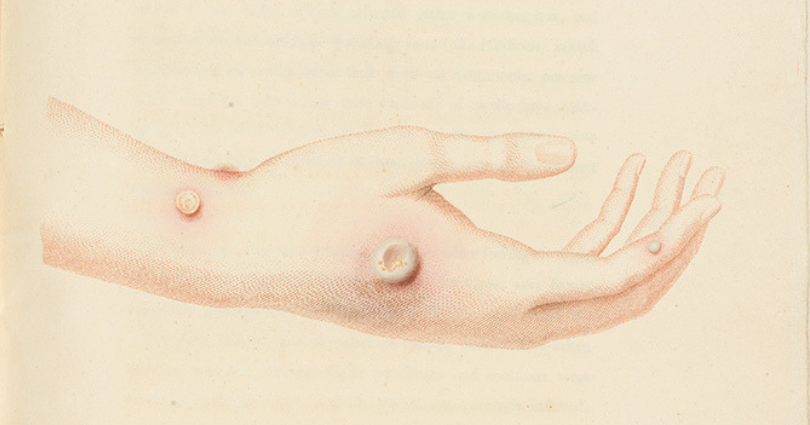No other word conjured up more fear among 18th century Americans than the word “smallpox.” The communicable and dreaded disease was a scourge and for good reason. While not everyone who was plagued with the malady died, those who contracted the disease suffered much, with symptoms ranging from fever, severe headaches, extreme muscular pain, profuse bleeding from bodily orifices, vomiting, and the appearance of an ugly rash with bumps filled with pustule across much of the body. At the age of 17, on a trip to Barbados with his half-brother Lawrence, aimed at treating Lawrence’s consumption (today known as tuberculosis) George Washington was stricken and lay infirm for several weeks. While he survived his face was forever scarred by the effects of “the pox.” From 1775-1782 a large scale smallpox epidemic ravaged all of North America and parts of South America. During the Revolutionary War it took its toll on the Continental Army. Unlike their European counterparts, who had been exposed for generations to the disease, many Americans were not. In terms of strength of numbers available for duty this gave the British an advantage.
Like most communicable diseases smallpox could be found concentrated in centers of large populations. Philadelphia, in particular, was susceptible to the disease. Several members of the Continental Congress contracted the disease during their tenure in the City of Brotherly Love. Even though scientists and physicians of the age were unaware of the idea of pathogens, they suspected rightly that the disease was spread by human contact; from particles in the air, for instance, and that breathing dispersed these particles onto other humans by direct and indirect contact, such as through particles that lived on pieces of cloth or clothing. In medical circles the term commonly used was “Variloa.” At the time the only way to treat the disease was to either avoid places where the airborne illness lodged itself or get inoculated, which was a risky business at best. Part of the exposure issue is that the disease incubates for two weeks before symptoms appeared so those who carry the germ, including those fortunate enough to be inoculated, continue to spread the diseases as they travel. At the time the disease proved fatal to one-third of those who contracted the disease.
Philadelphia seemingly became a hub for the disease as there was reluctance on the part of officials to instigate a program of inoculation. While the wealthy or well -connected could secure inoculation the poor for the most part did not, and children were particularly susceptible. But by spring 1776 Philadelphia had created an Inoculating or Smallpox Hospital where children could be treated. Among the affluent Patriots who secured inoculation were Thomas Jefferson, Benjamin Franklin, and Martha Washington. Many states and cities forbade inoculation for fear of spreading the disease.
As the Revolution dragged on Washington became increasingly concerned with smallpox and its impact on his army particularly because regiments recruited in the southern states had to travel through Philadelphia to reach Washington’s Army in either New York or New Jersey. This route of travel exposed many soldiers to the dreaded infirmity. Smallpox had ravaged the American Army that invaded Canada in the winter of 1775-1776. Congress wisely ordered troops moving north to skirt the city to avoid the plague. In 1776, the frustrated Commander-in-Chief wrote, “I would wish to have the small Pox intirely out of Philadelphia.” Correspondence between Washington and other leaders of the Revolutionary band express concern and alarm regarding the disease.
Smallpox also impacted the recruitment of soldiers into the Continental Army for fear of contracting the fatal disease. Some states balked or suspended recruitment based on this fear. Ironically on July 4, 1776 Connecticut Governor, Jonathan Trumbull wrote Washington, “Fear of the Infection operates strongly to prevent Soldiers from engaging in the Service, and the Battalions ordered to be raised in this Colony fill up slowly.” That same year General Philip Schuyler was concerned enough about the toll the fear of the disease was taking on the recruitment of militiamen in New York writing that many potential recruits were, “extremely apprehensive of being infected with the small pox and not without Reason as it proves fatal to many of them.” The same rang true in the southern states. Virginia delegate Edmund Pendleton wrote one of Washington’s subordinates, Richard Henry Lee in February 1777, a members of the Virginia encampment endured suffering that it “much retarded our inlistments.”
To counter both the fear and the actual disease itself George Washington ordered a bold move on February 6, 1777, to have the entire Continental Army inoculated. At this juncture it became a matter of policy. This act alone may have saved the Revolution. The process was simple. A physician lanced one of the infected patient’s pustules with a knife or scalpel and then inserted the infected blade under the skin of a healthy person. Generally the inoculated person contracted the disease, but in a much milder form.
The policy of inoculation was written by Washington in a directive to the Continental Army’s Medical Director, Dr. William Shippen. The directive ordered that all troops coming through Philadelphia were to be inoculated. Urgency was at stake with Washington writing, “Necessity not only authorizes but seems to require the measure, for should the disorder infect the Army . . . we should have more to dread from it, than from the Sword of the Enemy." Washington informed Congress a month later of the plan, which was carried out after that covertly, so the British were unaware of what Washington was doing. Washington chose to have his soldiers inoculated during the winter for strategic reasons. Fighting had ebbed and most campaigning took place during warmer weather. By inoculating his troops during the winter Washington adroitly gave his troops enough time to recover from the effects of inoculation before fighting commenced. Most of the inoculations took place at the Morristown, New Jersey encampment and in facilities in Philadelphia. The risk was enormous as less than a quarter of those serving at the time in the Continental Army had contracted the disease naturally.
Washington was always a better strategist than tactician. Even though he lost more battles than he won he had command of the larger picture. In this case he scored a seemingly impossible victory against an invisible enemy.

 www.battlefields.org
www.battlefields.org
Like most communicable diseases smallpox could be found concentrated in centers of large populations. Philadelphia, in particular, was susceptible to the disease. Several members of the Continental Congress contracted the disease during their tenure in the City of Brotherly Love. Even though scientists and physicians of the age were unaware of the idea of pathogens, they suspected rightly that the disease was spread by human contact; from particles in the air, for instance, and that breathing dispersed these particles onto other humans by direct and indirect contact, such as through particles that lived on pieces of cloth or clothing. In medical circles the term commonly used was “Variloa.” At the time the only way to treat the disease was to either avoid places where the airborne illness lodged itself or get inoculated, which was a risky business at best. Part of the exposure issue is that the disease incubates for two weeks before symptoms appeared so those who carry the germ, including those fortunate enough to be inoculated, continue to spread the diseases as they travel. At the time the disease proved fatal to one-third of those who contracted the disease.
Philadelphia seemingly became a hub for the disease as there was reluctance on the part of officials to instigate a program of inoculation. While the wealthy or well -connected could secure inoculation the poor for the most part did not, and children were particularly susceptible. But by spring 1776 Philadelphia had created an Inoculating or Smallpox Hospital where children could be treated. Among the affluent Patriots who secured inoculation were Thomas Jefferson, Benjamin Franklin, and Martha Washington. Many states and cities forbade inoculation for fear of spreading the disease.
As the Revolution dragged on Washington became increasingly concerned with smallpox and its impact on his army particularly because regiments recruited in the southern states had to travel through Philadelphia to reach Washington’s Army in either New York or New Jersey. This route of travel exposed many soldiers to the dreaded infirmity. Smallpox had ravaged the American Army that invaded Canada in the winter of 1775-1776. Congress wisely ordered troops moving north to skirt the city to avoid the plague. In 1776, the frustrated Commander-in-Chief wrote, “I would wish to have the small Pox intirely out of Philadelphia.” Correspondence between Washington and other leaders of the Revolutionary band express concern and alarm regarding the disease.
Smallpox also impacted the recruitment of soldiers into the Continental Army for fear of contracting the fatal disease. Some states balked or suspended recruitment based on this fear. Ironically on July 4, 1776 Connecticut Governor, Jonathan Trumbull wrote Washington, “Fear of the Infection operates strongly to prevent Soldiers from engaging in the Service, and the Battalions ordered to be raised in this Colony fill up slowly.” That same year General Philip Schuyler was concerned enough about the toll the fear of the disease was taking on the recruitment of militiamen in New York writing that many potential recruits were, “extremely apprehensive of being infected with the small pox and not without Reason as it proves fatal to many of them.” The same rang true in the southern states. Virginia delegate Edmund Pendleton wrote one of Washington’s subordinates, Richard Henry Lee in February 1777, a members of the Virginia encampment endured suffering that it “much retarded our inlistments.”
To counter both the fear and the actual disease itself George Washington ordered a bold move on February 6, 1777, to have the entire Continental Army inoculated. At this juncture it became a matter of policy. This act alone may have saved the Revolution. The process was simple. A physician lanced one of the infected patient’s pustules with a knife or scalpel and then inserted the infected blade under the skin of a healthy person. Generally the inoculated person contracted the disease, but in a much milder form.
The policy of inoculation was written by Washington in a directive to the Continental Army’s Medical Director, Dr. William Shippen. The directive ordered that all troops coming through Philadelphia were to be inoculated. Urgency was at stake with Washington writing, “Necessity not only authorizes but seems to require the measure, for should the disorder infect the Army . . . we should have more to dread from it, than from the Sword of the Enemy." Washington informed Congress a month later of the plan, which was carried out after that covertly, so the British were unaware of what Washington was doing. Washington chose to have his soldiers inoculated during the winter for strategic reasons. Fighting had ebbed and most campaigning took place during warmer weather. By inoculating his troops during the winter Washington adroitly gave his troops enough time to recover from the effects of inoculation before fighting commenced. Most of the inoculations took place at the Morristown, New Jersey encampment and in facilities in Philadelphia. The risk was enormous as less than a quarter of those serving at the time in the Continental Army had contracted the disease naturally.
Washington was always a better strategist than tactician. Even though he lost more battles than he won he had command of the larger picture. In this case he scored a seemingly impossible victory against an invisible enemy.

Washington Inoculates an Army
No other word conjured up more fear among 18th century Americans than the word “smallpox.” The communicable and dreaded disease was a scourge and for...
